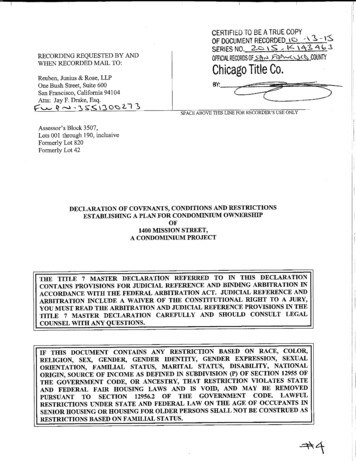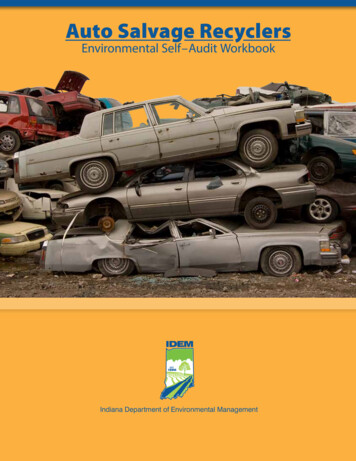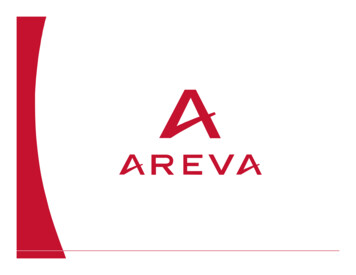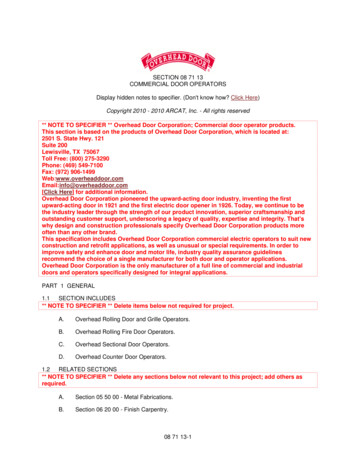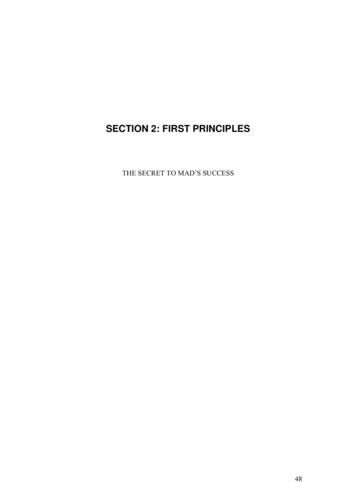
Transcription
SECTION 2: FIRST PRINCIPLESTHE SECRET TO MAD‟S SUCCESS48
Chapter 8: Intro to First PrinciplesBy Tim Sonnreich, from Tips, Tactics & First PrinciplesMaking Cases from First PrinciplesAs a novice or even intermediate debater you will constantly feel like you don‟t knowenough to debate most topics to their full potential – and unfortunately that‟s probablytrue. But how to you fix that lack of knowledge? You focus on first principles.First Principles has two key elements:(1) A good understanding of the principles of logic (i.e knowing how to show thatan argument is logically flawed without knowing any facts about the issue).(2) A good understanding of the key concepts that form the fundamental „clash‟ inthe debate - (see the next page for a basic list)Simply put, you can't prep a good case without having good and consistent IDEASabout a topic, and short of being an expert on every issue; these two elements are thebest way to generate those ideas in prep.NOTE: The language isn‟t that important. Don‟t worry about learning thelabels/jargon used in the list, it‟s the IDEAS that are important.None of this is meant to suggest that you shouldn‟t try to keep up with the news, andeven go further than that and specifically research issues that you think might beuseful – of course you should do that. But that‟s a process that will be on-goingthroughout your debating career. At the start you want to give yourself the bestpossible chance of building good cases on a wide range of issues – and first principlesis the best way to do that.The case prepping method outlined discussed previously is designed to show you howto build up a case by approaching it from first principles – incorporating both logicalprogression of ideas, as well as being able to identify and understand thephilosophical clash that lies at the heart of any debate.There are few short cuts to learning first principles. The best ways are to read and topay attention during debates/adjudications. All debates are built on a foundation ofconflicting ideas and theories about how to solve problems – like how to best run theeconomy (e.g. Keynesian or Neo-liberal?) or the best principles for a political system(e.g. communitarian or liberal?), etc. These ideas might sound complicated, but forthe purposes of debating you just need to understand the key concepts in each theory.66For more examples of how specific 1st P theories relate to a range of debates, see the matter articles inthe Members section of the MAD site, on democracy and secularism (etc) www.monashdebaters.com49
First Principles ExercisesIn 50-100 words describe the key features of the following philosophies/concepts.Governance1) Liberal democracy (some liberal democracies are more liberal than others)2) Social democracy (see Scandinavia).3) Guided democracy (see Singapore)4) DictatorshipEconomics5) Communism1) Efficient Market Hypothesis (Neoliberal)6) Regionalism („pooled sovereignty‟)2) Keynesian3) Behavioural economicsEnvironment1) Humanist ecology (Sustainable development)2) Technological ecologyMorality3) Deep-green ecology1) Kantian (people as ends, not means)4) Tragedy of the Commons2) Utilitarianism – (preference and hedonistic)Legal1) Social Contract theory2) J.S.Mill‟s Harm principle3) Aims of the Criminal Justice System4) Zero Tolerance („broken windows‟)5) Retributive Justice6) Restorative Justice („harm minimisation‟)Business (Corporate Social Responsibility)1) Stakeholder model2) Shareholders only3) Industrial DemocracyPolitics1) Liberalism2) Socialism/Communitarianism3) SecularismOthers1) Game TheoryScience1) Precautionary principleSecurity1) Collective & Cooperative Security2) Just war theory3) Pre-emptive and Preventative war4) „Golden Arches‟ peace theory5) „Democratic Peace‟ theoryAustralian Politics1) Federalism vs Unitary government2) Bi-cameral vs Uni-cameral3) Subsidiarity vs Centralised power4) Party discipline (Aust vs USA)5) MandatesFeminism1)2)3)4)Liberal feminismRadical feminismDeveloping-world feminismPower feminismInternational RelationsDevelopment Theories1) Dependency Theory2) Liberalisation (free trade)3) Export Promotion & Import Substitution4) Capital Controls5) „Development as Freedom‟ (Sen)1) Neoconservatism2) Realism3) Liberal Internationalism (multilaterialism)4) „Soft Power‟ vs „Hard Power5) „Constructive engagement‟ vs Sanctions50
Chapter 9: Rights & MoralsBy Amit GolderI am not a philosopher, philosophy lecturer nor a particularly good/hard working philosophystudent. Much of the content of this is stolen from first year philosophy subjects, so apologiesfor boring some of you to death. With that caveat in mind, please enjoy this brief introductionto moral and rights theory. If you want to know more, use the words/names that are bold andunderlined as the start of your wikipedia-ing/ actual research.1MORALSUtility vs Deontology – the central dichotomy of all moral discussions. Should we analyseideas and conduct by looking to their consequences or their intrinsic moral rightness orwrongness?Utility – something is good if it leads to the best outcomes- But what are the best outcomes? Most preferences fulfilled? Most urgent preferencesfulfilled? Greatest net happiness?- No extra importance is placed on the lives of those with special relationships to you(family/friends)- Does not care about rights! As Bentham said, the notion of rights is “nonsense on stilts”.Deontology – fuck the consequences, things are moral if they follow rules. Something is goodif its good (right?), that is, if it follows the rules of being good. For example, for manyphilosophers, the exercise of reason (rational thought) is something that is just good.7 ForKant, the unique capacity of human beings to exercise rationality means that each individualmust always be treated as an ends in and of themselves, and never as a means to an end.That‟s his rule, and so following that is morally correct. Wonder what he‟d think of medicaltesting on people?Note: if you are actually a deontological, rights-based thinker (as many of us claim to be) youcan‟t abandon rights when it‟s convenient. The whole point of something being a right is thatit can‟t be traded away, that it is non-derogable, as Dworkin would say, that “rights aretrumps”.Now for a classic ethics thought experiment:A tram is running out of control down a track. In its path are 5 people who have been tied to the track.Fortunately, you can flip a switch, which will lead the trolley down a different track to safety.Unfortunately, there is a single person tied to that track. Should you flip the switch?Obviously, a utilitarian would flip the switch. A deontological moral system might not be soquick to approve of that. Yes more people will be saved, but the person flipping the switchbecomes much more closely involving in choosing to end someone‟s life – possibly leading togreater moral culpability.**********7See also: the enlightenment51
In debating-land (where we all live) utility almost always wins. I don‟t mean that in acompetition between a utilitarian account of something and a rights-based account, theutilitarian will always win. I mean that most debates occur within a solely utilitarianparadigm, where consequence is the only metric of value. This is something that Australiandebaters are accused of a lot – ignoring principle. I can understand why this is so – its mucheasier to explain why something will/won‟t lead to certain outcomes, as opposed toexplaining why something is morally right or wrong.A debate which illustrates this clash is “That we should torture terrorist suspects forinformation”. The affirmative will typically outline a utilitarian case – basically that tortureleads to potentially life-saving information. The negative will often rebut this utilitarian ideaby saying that it leads to poor information/lies and that it ruins interactions with keystakeholders etc. The negative can also argue that, further to the disutility of torture, it is alsoimmoral to violate someone‟s bodily integrity, cause them pain and suffering and diminishtheir autonomy – particularly where that person is merely suspected of wrongdoing. In thisexample, the negative, but not the affirmative, have dealt with the principled component ofthe argument.2RIGHTSWhen we talk about rights we‟re talking about many things. Human rights tend to controlwhat humans can do to themselves/each other, what the state can do to us and what we canlegitimately expect/demand from the state.Sources of RightsGod? Do we have rights because God gave them to us?- excludes certain people/ living things- excludes certain things as rights ie taking life (abortion, euthanasia)Utility? Do we have certain rights because the best consequences flow from having them?- Maybe social cohesion/trust/ basic functionality require respect for life and autonomyo Major justification for eg. property rights (patenting)- Does this mean that if they aren‟t useful/don‟t generate the best outcomes, rights canbe ignored? Torture example again Inherent in Humans? This is what Kant would say – why?- Because we have souls? Not us atheists - Rational Capacity? What about babies and the severely disabled?Social Contract? The social contract is an implicit/artificial agreement between society/thesovereign/the state and the people to alter the distribution of rights. There can be twoconceptions of the social contract as it relates to the formation of rights:- Citizens agree to reduce their individual freedoms in exchange for collective benefitsprovided by the state. In effect, ceding some rights in exchange for protection; or- Citizens collectively agree on what rights people do/do not have – meaning that rightsare culturally specific and can vary.Types of Rights52
1. Negative (Liberty Rights) – these are freedoms that you have and that most people canexercise from without the help of the state. The role of the state in facilitating negativerights is to not restrict them, and not allow others to eg by using the criminal law. Anexample of a negative right is freedom from pain/torture.2. Positive (Benefit Rights) – freedoms which require the active support and participationof the state to materialise. The role of the state here is to actively do/provide something,so that these rights can be activated. For example, the right to education is usuallyconsidered a positive right, meaning the state is obliged to provide this for all.3. Individual – rights that correspond to people and not communities, other groups, nationsetc. The United States, and its Bill of Rights, is a prime example of a society/documentwhich preferences individual conceptions of rights. Individual rights are closelyassociated with liberty rights – freedom to do what you want and so on.4. Community – rights that accrue to communities, not just the individual constituents thatcomprise them. Similar to the social contract, the principle here is that sometimesindividual rights can be either damaging to, or just less important than, community-widebenefits. Communitarian theory usually involves advocating for positive rights – thestate doing things for the community, eg welfare. Communitarian accounts of humanrights are popular in Scandinavian/Northern European nations.5. Legal Rights – this is a stricter account of rights than many of the above, which holds thatrights are things that can be sued against for infringements. For example, if aconstitution/bill of rights has a „right to housing‟ (eg South Africa), then technically youcan sue the government if they fail to provide those rights. This is stricter, because manythings we would consider rights are not enshrined in explicit laws which give standing tosue the government.The Limits of Rights1. The Harm PrincipleWhere do rights end? Pretty simple, when they conflict with other rights!This smart dude called JS Mill enunciated a clever theory for when it should be acceptablefor the government to limit your rights and freedoms: when their exercise reduces the rightsand freedoms of others. That‟s why, for example, the government can legitimately usecoercive force to imprison people who assault others.But it‟s hard to define the border of when the exercise of one right actually starts impingingon the rights of others. What about drug-taking? Certainly, if it involves assault or theft, that‟sharm to others and the state can stop you doing that. But what if it‟s only self-regardingconduct? It could be argued that in welfare states, voluntarily harming yourself drainsresources from welfare and healthcare, which harms other citizens. This is far from a directharm justifying state intrusion though. But it is the principle behind, for example, mandatoryseatbelt and helmet laws. Its hard to find a satisfactory line which includes intuitively badthings, such as drugs and public nudity, but excludes things like drinking alcohol and eveneating meat!Mill‟s harm principle, as described above, is all about negative rights – what about positiverights? Can the government justifiably reduce some of your rights, not because you‟reimpinging on the freedom of others, but to grant extra freedoms to others? Sounds crap,right? But that is (to be fair only one part of) the justification behind redistributive taxation.53
2. Consent The Paternal StateAnother option for where the state can justifiably intrude on human rights and freedoms iswhere people don‟t/can‟t consent. Why can the state force children to go to school or preventthem from getting tattoos or engaging in sex below a certain age? Because as a society we‟vedecided that people who are young (or perhaps cognitively incapable) cannot consent tocertain activities and therefore do not have the freedom to engage in them.That makes a lot of intuitive sense, and is particularly true if you believe that human rightsflow from our rational capacity. But what about cases where consent is just unclear. An adultis judged to be able to consent to smoking a cigarette (or 1,000), despite
enough to debate most topics to their full potential – and unfortunately that‟s probably true. But how to you fix that lack of knowledge? You focus on first principles. Simply put, you can't prep a good case without having good and consistent IDEAS about a topic, and short of being an expert on every issue; these two elements are the best way to generate those ideas in prep. None of this .

